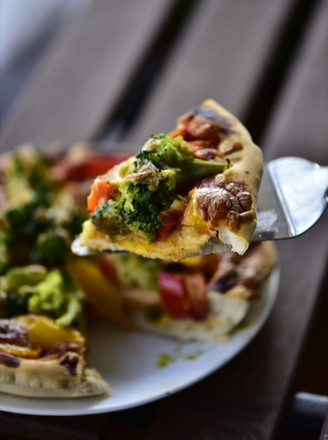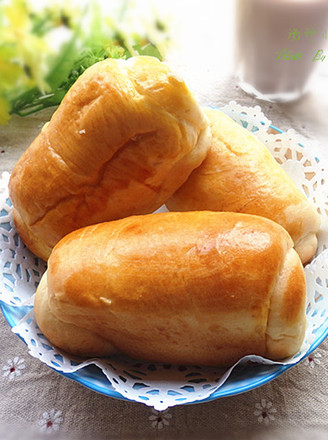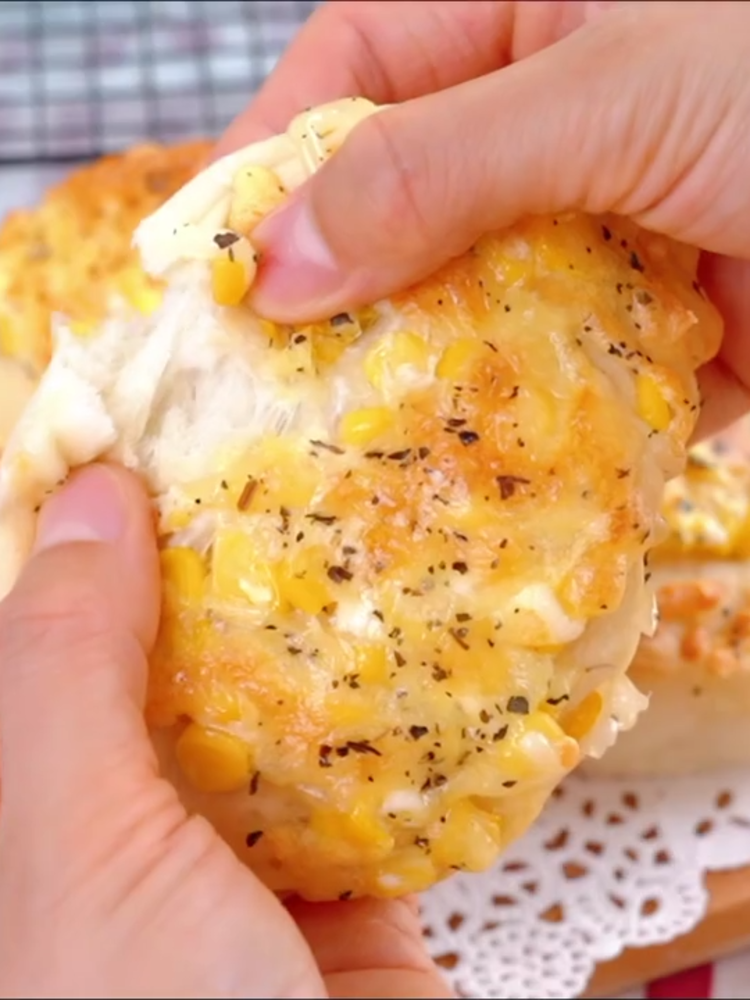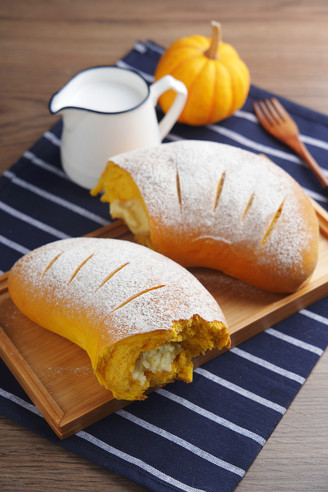[cream Caramel Shredded Bag]: Enjoy The Fun of Sucking Your Fingers
1.
Dissolve the yeast powder in warm milk and mix with other ingredients except salt and butter;
2.
After the oil method, the dough is kneaded to a fully expanded state, that is, a large thin and tough film can be easily pulled apart;
3.
The dough at this time should be very smooth and not sticky;
4.
Put the dough in a mold, cover it with plastic wrap, and place it in a warm place for basic fermentation. In winter, the room temperature is low, you can use the fermentation function of the oven;
5.
After about 1 hour, the dough will grow to twice the size of its original volume. Dip dry powder with your fingers, poke the hole without shrinking or collapsing, and the basic fermentation is over;
6.
Take out the dough, vent it, and roll it out into a rectangle;
7.
Divide the dough evenly into 4 equal parts;
8.
Mix the creamy caramel sauce and butter in the spread, then take about 2/3 of the amount and spread it evenly on the divided dough;
9.
Overlap the four noodles;
10.
Divide the folded dough into 4 equal parts;
11.
The mold is greased and powdered in advance, and the divided small doughs are arranged in a circle around the chimney in the middle. Then cover it with plastic wrap and place it in a warm and humid place for secondary fermentation. If the room temperature is low, you can use the fermentation function of the oven;
12.
After about 50 minutes, the dough will rise to 1.5 times to twice its original volume. Brush the remaining 1/3 of the cream caramel sauce on the surface of the dough;
13.
Preheat the oven 190 degrees in advance. After the preheating is over, put the mold into the oven, 180 degrees, the lower and middle layer, the upper and lower fire, bake for 15-20 minutes, until the dough is enlarged and the surface is golden and colored;
14.
After the baking is over, immediately take it out of the oven, leave it for a while, unmold the bread and place it on a drying net, cool to room temperature and not hot, and then it can be sealed and stored. Take out before eating and sprinkle with powdered sugar or fine coconut.

![[cream Caramel Shredded Bag]: Enjoy The Fun of Sucking Your Fingers recipe [cream Caramel Shredded Bag]: Enjoy The Fun of Sucking Your Fingers recipe](https://img.simplechinesefood.com/c0/c0d9bdb4a3ad2e57dfe3b8c537e61db3.jpg)
Tips:
1. In winter, the room temperature is lowered, so first mix the yeast powder and milk. This is an activation process. In addition, it is best to heat the milk in advance to a state where it is warm and not hot;
2. The amount of liquid is adjusted according to the actual situation, and the final kneaded dough is very soft and not sticky;
3. The fermentation time should be decided according to the actual situation. In the first fermentation, the dough will not shrink or collapse after being pierced down, and it will be fermented. In the second fermentation, the dough will grow to 1.5~2 times the original volume. After lightly pressing it with your fingertips, it will slowly bounce back. There will be no traces on the surface of the dough and it can be baked. For the second fermentation, the principle of "Preferring less than more" should be adopted, and never overdo it;
4. The specific baking time should also be determined according to the different conditions of each oven. If the color is too dark in the middle, you can add a layer of tin foil;
5. After the bread is baked, it can be bagged and sealed as long as it is cooled to room temperature and not hot to prevent the bread from being air-dried.

![[cream Caramel Shredded Bag]: Enjoy The Fun of Sucking Your Fingers [cream Caramel Shredded Bag]: Enjoy The Fun of Sucking Your Fingers](https://img.simplechinesefood.com/46/46a7114c8d83ee980a1013a85691ac59.jpg)
![[cream Caramel Shredded Bag]: Enjoy The Fun of Sucking Your Fingers recipe [cream Caramel Shredded Bag]: Enjoy The Fun of Sucking Your Fingers recipe](https://img.simplechinesefood.com/67/670b7441bb39d12ef84b482ff9c4a7bb.jpg)
![[cream Caramel Shredded Bag]: Enjoy The Fun of Sucking Your Fingers recipe [cream Caramel Shredded Bag]: Enjoy The Fun of Sucking Your Fingers recipe](https://img.simplechinesefood.com/68/68d61eb5fac3e80770a5c0a9172fc497.jpg)
![[cream Caramel Shredded Bag]: Enjoy The Fun of Sucking Your Fingers recipe [cream Caramel Shredded Bag]: Enjoy The Fun of Sucking Your Fingers recipe](https://img.simplechinesefood.com/bb/bbb485eab0f8e8ef7e1d727ee0471a9d.jpg)
![[cream Caramel Shredded Bag]: Enjoy The Fun of Sucking Your Fingers recipe [cream Caramel Shredded Bag]: Enjoy The Fun of Sucking Your Fingers recipe](https://img.simplechinesefood.com/1f/1f30ceb5fb80b9e70b63b00289b6ee3a.jpg)
![[cream Caramel Shredded Bag]: Enjoy The Fun of Sucking Your Fingers recipe [cream Caramel Shredded Bag]: Enjoy The Fun of Sucking Your Fingers recipe](https://img.simplechinesefood.com/f7/f7525a14d5d86b30d0041a6b6941b915.jpg)
![[cream Caramel Shredded Bag]: Enjoy The Fun of Sucking Your Fingers recipe [cream Caramel Shredded Bag]: Enjoy The Fun of Sucking Your Fingers recipe](https://img.simplechinesefood.com/c9/c943eaf274b6d4607b4749f13238da70.jpg)
![[cream Caramel Shredded Bag]: Enjoy The Fun of Sucking Your Fingers recipe [cream Caramel Shredded Bag]: Enjoy The Fun of Sucking Your Fingers recipe](https://img.simplechinesefood.com/5b/5b87d5f81ff52e69ee44835bcac258d2.jpg)
![[cream Caramel Shredded Bag]: Enjoy The Fun of Sucking Your Fingers recipe [cream Caramel Shredded Bag]: Enjoy The Fun of Sucking Your Fingers recipe](https://img.simplechinesefood.com/d5/d533815e4d03ec313099abbcb84857fa.jpg)
![[cream Caramel Shredded Bag]: Enjoy The Fun of Sucking Your Fingers recipe [cream Caramel Shredded Bag]: Enjoy The Fun of Sucking Your Fingers recipe](https://img.simplechinesefood.com/8c/8cd4c9850b6edf0d6d314e8df1ccdf39.jpg)
![[cream Caramel Shredded Bag]: Enjoy The Fun of Sucking Your Fingers recipe [cream Caramel Shredded Bag]: Enjoy The Fun of Sucking Your Fingers recipe](https://img.simplechinesefood.com/76/766d559121ef871a6d4d1261f30aa0ed.jpg)
![[cream Caramel Shredded Bag]: Enjoy The Fun of Sucking Your Fingers recipe [cream Caramel Shredded Bag]: Enjoy The Fun of Sucking Your Fingers recipe](https://img.simplechinesefood.com/d1/d1a65614d94cb1449662bb3fb78aca7c.jpg)
![[cream Caramel Shredded Bag]: Enjoy The Fun of Sucking Your Fingers recipe [cream Caramel Shredded Bag]: Enjoy The Fun of Sucking Your Fingers recipe](https://img.simplechinesefood.com/e3/e3a6e676107a0f7ee2198f5926ad9558.jpg)
![[cream Caramel Shredded Bag]: Enjoy The Fun of Sucking Your Fingers recipe [cream Caramel Shredded Bag]: Enjoy The Fun of Sucking Your Fingers recipe](https://img.simplechinesefood.com/8a/8aaaa70f6326d140c5c26a7f825ccb3d.jpg)
![[cream Caramel Shredded Bag]: Enjoy The Fun of Sucking Your Fingers recipe [cream Caramel Shredded Bag]: Enjoy The Fun of Sucking Your Fingers recipe](https://img.simplechinesefood.com/c0/c0d9bdb4a3ad2e57dfe3b8c537e61db3.jpg)







